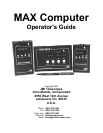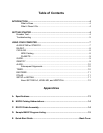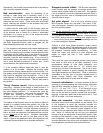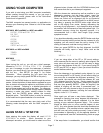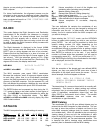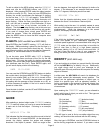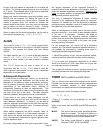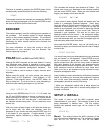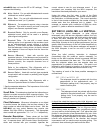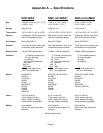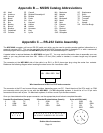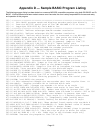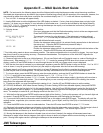
Page 8
the star you are pointing at is indeed the one selected in the
MAX computer.
For indoor familiarization, the alignment process may be
simulated to allow access to additional modes (attempting
to select some modes before the alignment process has
been completed will result in a
STAR SIGHTINGS ARE
REQUIRED message).
RA DEC
This mode displays the Right Ascension and Declination
(coordinates) of the direction the telescope is currently
pointed. By use of an internal sidereal clock, the MAX
computer will work properly with or without a clock drive
running. This means that users not using a clock drive will
be able to watch the Right Ascension slowly increase with
time as the Earth rotates.
The Right Ascension is displayed in the format HHMM
(hours and minutes) and the Declination is in the format
±DDTT (plus or minus degrees and tens of arc minutes).
Please note that the Declination is to tens of minutes, not
tenths of a degree (thus the digits 6-9 never appear in the
last column). With the telescope pointed at R.A. (Right
Ascension) 12 hours 36 minutes and Dec. (Declination) +26
degrees 42 minutes, the display would read:
NGC-MAX:
R=12h36 D=+26°42
miniMAX / microMAX:
1236+264
The MAX computer uses epoch 2000.0 coordinates.
Because the computer "sees" all stars and objects relative
to each other, rather than to an Earth-based coordinate
system, the Earth's precession is not a factor in the pointing
accuracy of the MAX computer. Only the reported R.A. and
Dec. are affected by precession, therefore any user defined
objects should be entered with epoch 2000.0 coordinates.
The ENTER button can be pressed any time during the
RA
DEC
mode to display a star chart number for that region of
sky. The NGC-MAX can display information for either the
Sky Atlas 2000.0 or Uranometria charts. The NGC-
miniMAX and NGC-microMAX units only display Sky Atlas
2000.0 chart numbers.
CATALOG
The MAX computers have several catalogs in memory:
Model
ST M NGC IC P NEW NS/DS
NGC-microMAX 90 110 28 17
NGC-miniMAX 80 110 2745 960 9 28 86
NGC-MAX 928 110 7840 2852 9 28 386
ST Unique compilation of most of the brighter and
interesting stars (including many doubles)
M Messier catalog (deep-sky)
NGC Revised New General Catalog (deep-sky)
IC Index Catalog (deep-sky)
Planets Eight major planets and the Sun (alias "DATE")
NEW User-definable list of object coordinates
NS/DS Unique compilation of non-stellar, deep-sky
objects.
The user definable list contains the coordinates of any
objects you wish, and can only be changed by writing new
information over the old. In other words, even without a
battery, the list is retained within the MAX computer until
you want to change it.
Upon entering the
CATALOG mode, use the UP/DOWN
buttons to select which catalog you wish to use, and then
press ENTER. You will now be permitted to define the
specific catalog number (2-4 digits, depending on the
catalog) one digit at a time, or planet name. This is
accomplished through a process similar to setting a digital
watch. Use the UP/DOWN buttons to define each digit,
then ENTER to continue on to the next. If your desired
number is of fewer digits than requested, you will need to
use preceding zeros (e.g. - for M1 you would enter
M001).
After ENTERing the last digit, the coordinates for that object
will be displayed, similar to the following:
M001 0534+220
With the exception of the planets and user defined (NEW)
objects, you may now press ENTER once more to see a
description of the object scroll across the screen. For our
above example, this would appear as follows:
M001 MAG= 8.4 SIZE=5.8 CRAB
NEBULA SUPERNOVA REMNANT TAURUS
NEBULA SA=05
The descriptions fit a common format which is normally self-
explanatory. This format is: object catalog and number;
magnitude; size (in minutes unless followed by "); common
name (if applicable); constellation; object type; and Sky
Atlas 2000.0 or Uranometria chart number. The smaller
NGC-microMAX database does not include size,
constellation or type information.
NEW Catalog
The coordinates for up to 28 user defined objects may be
entered into the MAX computer for later reference. This can
be used to store the positions of objects not found in the
other MAX computer catalogs (such as comets, asteroids
and variable stars). While it is possible to plan an evening's
viewing ahead of time and put the coordinates of each
object in the NEW catalog, it is recommended that the built-
in catalogs (M, NGC, etc.) be used whenever possible. This
is because the built-in catalogs store coordinates more
precisely than is allowable under the NEW catalog.



